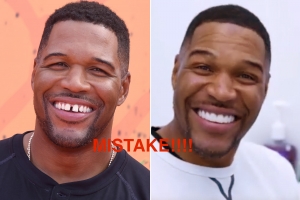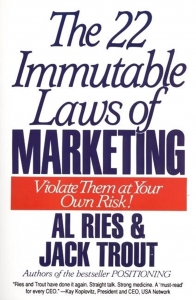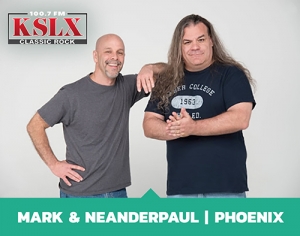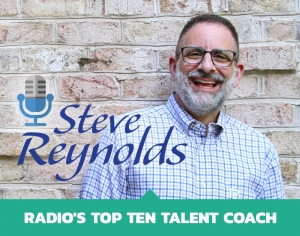Michael Strahan and The Power Of A Difference
 Michael Strahan removed the gap between his front teeth, and I can’t figure out why. It’s one of the distinguishing physical characteristics of the NFL on Sunday and Good Morning America host.
Michael Strahan removed the gap between his front teeth, and I can’t figure out why. It’s one of the distinguishing physical characteristics of the NFL on Sunday and Good Morning America host.
Think Robert DeNiro’s mole, Tom Selleck’s moustache, and Barbra Streisand’s nose. Distinct, unique, it’s part of their brand.
Why would someone erase something that made them different?
 Ries and Trout talk about points-of-parity and points-of-differentiation in their iconic book, The 22 Immutable Laws of Marketing. They ask the question, and I, in turn, ask every personality I work with: what is noticeably different about what we do that helps us stand out?
Ries and Trout talk about points-of-parity and points-of-differentiation in their iconic book, The 22 Immutable Laws of Marketing. They ask the question, and I, in turn, ask every personality I work with: what is noticeably different about what we do that helps us stand out?
To the audience, we live in a “sea of the same”. That’s our starting point to the uninitiated. That we’re another “him and her” morning show that talks a lot and has wacky bits. Our job over time is to develop bold points-of-differentiation to separate ourselves from our competitors and define the images we want to be known for.
So, I engage every show on this: besides you, what do we do that no one else does? What makes us stand out? As someone who’s sat in his share of focus groups, if listeners cannot answer this unaided, you’ve got some trouble. Find those points-of-differentiation. The more you have, the more distinct you are
Listeners only get big things – nuance never cuts through. Saying you do a phone topic every morning at 6:50 won’t cut it. Here are examples of what will:
- At MIX 104.1, Boston we do a feature each morning at 7:45 that is so unique and now so embedded in the audience’s life that our PPM meters triple and sometime quadruple at that time. Big and different.
- Bert Weiss is a smart, strategic thinker. When he started The Bert Show on Q100, Atlanta, he added into the cast an openly gay female who was quite comfortable sharing her life. She added deep hues to the perspective of the show and made the conversation more interesting. Listeners knew when they were listening to that show. Big and different.
- When Frank and Wanda were the morning show on V103, they had Miss Sophia, Atlanta’s most popular drag queen, do their Hollywood report each morning at 7:20. Three guesses what she brought the show in imagery and ratings. Big and different.
- The Josie Dye Show, Indie 88, Toronto does a huge and unique community service project each December. They ask the audience to donate socks to homeless shelters. They get 200,000 pair every year. Big and different.
The entire thing turned out to be an April Fool’s Day prank Strahan pulled to cause talk (that was big and different). Had he actually erased the gap, it wouldn’t have made him any less interesting or engaging. But it would have taken away a trait that made him look different.
As Seth Godin said recently, distinctive isn’t easy, but it’s worth it.
It might be an interesting strategic exercise to sit with your morning show and list your true points-of-differentiation. They need to be big. The longer the show’s been on, the more you should have.
Hope you have a decent list. Unless I’m competing against you in the market with another show.

 A focus of our content at some stations is the music. It’s an area often missed by personalities – to talk about the artists and songs you play. It’s smart to do because it further ingrains you into the fabric of the radio station and is a primary reason listeners choose your brand (at least initially). We do a lot of this on Mark and NeanderPaul, KSLX, Phoenix, who recently interviewed Paul Stanley from the iconic group KISS. As a classic rock station, this is like a three-foot putt, given how much the audience loves the music and that content based on nostalgia truly works when times are tough. What Mark and Paul do so well is get the artists to reveal themselves. Stanley comes on to sell his latest downloads, which are remakes of 1970s R&B songs. That’s his objective. Ours is to entertain the audience. This interview works on two levels: Stanley reveals himself because the guys ask questions that compel those stories. They then serve Stanley’s goals by talking about the new project, and quizzing him on his true knowledge of that music. Wrapped all around the conversation is a great use of audio to keep the listeners engaged.
A focus of our content at some stations is the music. It’s an area often missed by personalities – to talk about the artists and songs you play. It’s smart to do because it further ingrains you into the fabric of the radio station and is a primary reason listeners choose your brand (at least initially). We do a lot of this on Mark and NeanderPaul, KSLX, Phoenix, who recently interviewed Paul Stanley from the iconic group KISS. As a classic rock station, this is like a three-foot putt, given how much the audience loves the music and that content based on nostalgia truly works when times are tough. What Mark and Paul do so well is get the artists to reveal themselves. Stanley comes on to sell his latest downloads, which are remakes of 1970s R&B songs. That’s his objective. Ours is to entertain the audience. This interview works on two levels: Stanley reveals himself because the guys ask questions that compel those stories. They then serve Stanley’s goals by talking about the new project, and quizzing him on his true knowledge of that music. Wrapped all around the conversation is a great use of audio to keep the listeners engaged. Storytelling is an art and a major part of the telling of a great story is the details you share to drive the narrative. Consider learning that your dad fathered another child and you found out about it from your drunk sister. And…that the sibling you never knew you had lives in the city in which you live. It’s a pretty compelling narrative. And it works for several reasons: it’s the truth, there are some gasp-worthy details, and the story lives on the margins. You’re revealing yourself to the audience with intimate details you wouldn’t just share with anyone. And each detail is more shocking than the last. That’s the thesis of the story told on Moug and Angie, MIX 106, Boise, Idaho recently. Moug found out what his father did several years prior and thinks he saw his sibling in town based on a description. This is excellent storytelling. Another great decision made in the structure of this break is its first few minutes, where the team has a listener tell their crazy story first, which tees up Moug to tell his. I love that they put the focus first on a caller to hook the audience than what’s typically done, which is focus on the talent first. All around, these are two stories you will long remember. Moug is defined in the process, setting him up for listener questions about all of it down the road because it’s so memorable
Storytelling is an art and a major part of the telling of a great story is the details you share to drive the narrative. Consider learning that your dad fathered another child and you found out about it from your drunk sister. And…that the sibling you never knew you had lives in the city in which you live. It’s a pretty compelling narrative. And it works for several reasons: it’s the truth, there are some gasp-worthy details, and the story lives on the margins. You’re revealing yourself to the audience with intimate details you wouldn’t just share with anyone. And each detail is more shocking than the last. That’s the thesis of the story told on Moug and Angie, MIX 106, Boise, Idaho recently. Moug found out what his father did several years prior and thinks he saw his sibling in town based on a description. This is excellent storytelling. Another great decision made in the structure of this break is its first few minutes, where the team has a listener tell their crazy story first, which tees up Moug to tell his. I love that they put the focus first on a caller to hook the audience than what’s typically done, which is focus on the talent first. All around, these are two stories you will long remember. Moug is defined in the process, setting him up for listener questions about all of it down the road because it’s so memorable The two things which drive the success of realty shows on TV are very well-defined characters and drama, drama, drama. The next time you venture into your favorite realty show, watch them through these prisms and know that this is what drives great radio breaks, too. Another element of great realty shows is relatabiilty – as viewers, we must relate to the drama – possibly see that it could be us in that dilemma, as well. Enter The Josie Dye Show with Matt and Carlin, Indie 88, Toronto who see that relatable drama lives around them all the time. The show regularly gets emails from their promotions director and something about each email irks them: they always have the red flag that notes the email is urgent. This bugs all of them because not every message from her is urgent, in their opinion. So what do they do? They call the promotions director and confront her, asking why she does it and asks that she stop. In one word: drama. A break like this works because listeners have lived it (or see that they could) and in their fantasies, they’d make the same call. The only thing is that these guys did make the call. So listeners lean in to see how it goes. Just like a great scene in your favorite reality show on TV.
The two things which drive the success of realty shows on TV are very well-defined characters and drama, drama, drama. The next time you venture into your favorite realty show, watch them through these prisms and know that this is what drives great radio breaks, too. Another element of great realty shows is relatabiilty – as viewers, we must relate to the drama – possibly see that it could be us in that dilemma, as well. Enter The Josie Dye Show with Matt and Carlin, Indie 88, Toronto who see that relatable drama lives around them all the time. The show regularly gets emails from their promotions director and something about each email irks them: they always have the red flag that notes the email is urgent. This bugs all of them because not every message from her is urgent, in their opinion. So what do they do? They call the promotions director and confront her, asking why she does it and asks that she stop. In one word: drama. A break like this works because listeners have lived it (or see that they could) and in their fantasies, they’d make the same call. The only thing is that these guys did make the call. So listeners lean in to see how it goes. Just like a great scene in your favorite reality show on TV.